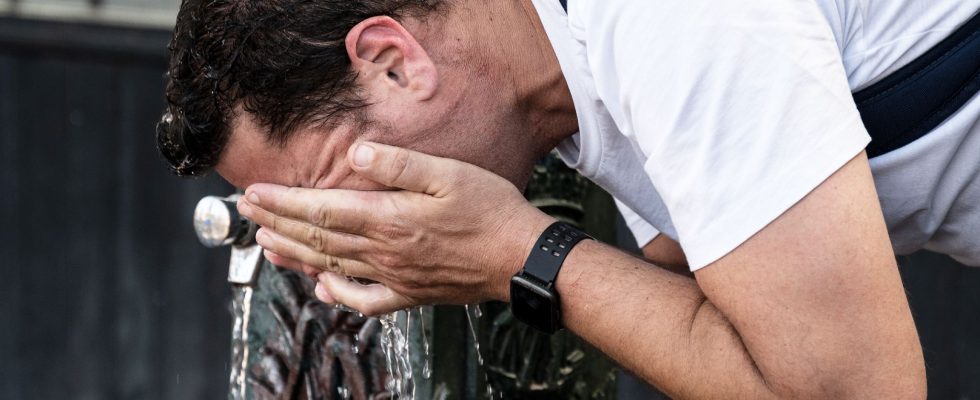“The heat kills silently, and there is no escape yet.” The sentence was pronounced by Eleni Myrivili during a conference in Vancouver (Canada) in March 2022. Before, therefore, the summer of the same year, whose scenario only reinforced her tragic observation: more than 61 000 deaths are attributable to heat in Europe between the end of May and the beginning of September 2022, according to a study recently published in the journal Nature Medicine. The current summer period could be even more deadly since July will “most certainly be the hottest month ever measured”, according to the World Meteorological Organization (WMO) and the European observatory Copernicus. Above all, the native country of Eleni Myrivili, Greece, is ravaged by flames, after having suffocated under one of the longest heat waves in recent decades.
Warmth is at the heart of Eleni Myrivili’s work. This expert was chief heat officer (or CHO, depending on the current acronym), be heat manager for the city of Athens between 2021 and last May. Since then, the granddaughter of Stratis Myrivilis, one of the most famous Greek novelists of the 20th century, has risen to prominence: global chief heat officer at UN-Habitat. Symbol of the importance taken by the issue of extreme heat in urban areas, Athens was a pioneer in Europe for the creation of a high-ranking position in local administration. Its mission: to unify the response of the various community services to a problem that is only getting worse due to global warming. Only Miami, in the United States, had preceded it by a few months. Many cities such as Los Angeles, Phoenix, Santiago de Chile, Melbourne and Freetown have since adopted them.
“The subject infuses everywhere”, confirms Hélène Chartier, director of urban planning and architecture of the global network C40 Cities. Because the projections augur a serious heat stroke : in 2050, nearly 970 cities, or 1.6 billion people, will experience average summers at 35° or more. All cities are thus seeking to renature, reduce and diversify sources of freshness, by targeting vulnerable groups: the elderly, school children, etc. Those that do not yet have a “heat manager”, or even an entire center as in Paris – the one of the most advanced capitals on the subject – can now be counted on the fingers of one hand.
Anticipating the city of the future
The scope of the position sometimes goes beyond the sole issue of the thermometer. “It all depends on the profile of the cities”, notes Hélène Chartier. For Rotterdam, Amsterdam or Copenhagen, rising sea levels and flooding represent a more immediate danger than that of heat waves.
These are “technical subjects, which affect many services”, confirms Vincent Viguié, researcher at the International Center for Research on the Environment and Development (Cired). Hence the importance of integrating them upstream into reflections on the city of the future. “Otherwise, there is a risk of having a delay and of putting measures in place only after the impacts have taken place”, he fears. Municipalities, however willing they may be, cannot do this alone. “Their actions are sometimes limited by national regulations, continues the researcher. In fact, the French strategy against the heat wave is, for the moment, not up to the challenges.”
The fight against this “silent killer” is not new. The American philanthropic foundation Rockefeller tried it in 2013 with his project “100 Resilient Cities”. The objective: to train one hundred employees in as many cities to guide them towards better adaptation to climate change. The program was liquidated after six years of existence, 85 people trained and $164 million in grants. Officially, to redirect the work of the foundation to “other paths”, even if the reasons for this choice are nebulous – some point to poor management of funds.
No matter, the attempt will have opened a path. “It was a precursor,” admits Hélène Chartier, whose C40 network, like others of its kind, took over. As did the Adrienne Arsht-Rockefeller Foundation Resilience Center (Arsht-Rock), which persisted by restarting a program, more restricted this time, against extreme heat. This organization is at the initiative of the first chief heat officer in 2021. Arsht-Rock now claims eight worldwide, all women.
No team or budget
Surella Segú was part of the club. She carried out this mission for a year in Monterrey (Mexico), her hometown, between 2022 and 2023. Not being a member of the municipality, she constantly had to defend her role with her colleagues and the population. “People were skeptical. They wondered what the post was for – and some continue to have doubts. This year’s heat wave and last year’s drought have partly lifted that disbelief,” he said. -She.
Not enough, however, to trigger all the desired actions. “When I spoke to officials from different departments, they showed interest. But when it came time to take the plunge, to carry out work, it was very complicated.” Although the architect was directly linked to the mayor, she had neither a team nor a budget. A limited influence, observed in other metropolises. “In Milan, the position is important but its occupant is a bit lonely, recognizes Hélène Chartier, of C40. The next step is to devote an entire department to it to preach the good word to all the others.”
“If we give the necessary weight and means to this function, it can be very effective so that current and future city projects systematically integrate this theme, which is linked to heat, but also to water, vegetation and many other subjects… We could make real transformations”, assures Surella Segú, still not replaced in Monterrey but still in contact with the Arsht-Rock foundation to define a mission at the national level. “We need a cultural change, she concludes. We make global warming tangible, it’s not just another concept. We can see it and experience it.”
